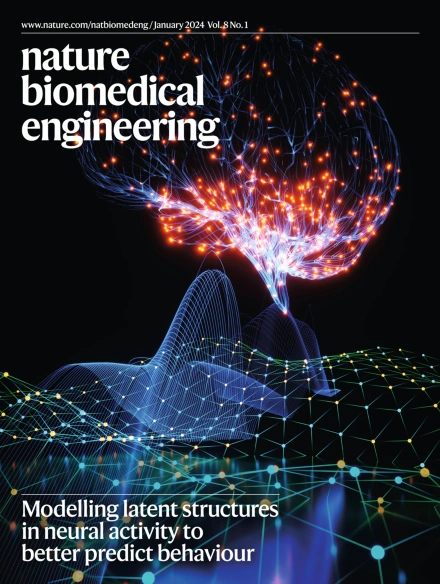Engineered thoracic spinal cord organoids for transplantation after spinal cord injury.
IF 26.8
1区 医学
Q1 ENGINEERING, BIOMEDICAL
引用次数: 0
Abstract
Stem-cell-based neural tissue engineering and spinal cord organoids show promises for spinal cord injury repair. However, the native spinal cord presents cell heterogeneity and a stereotypical spatial structure that makes difficult their recapitulation within an organoid architecture, which requires an assembly encompassing cellular composition, segmental organization and dorsoventral features. Here we engineer a thoracic vertebral segment-specific spinal cord organoid (enTsOrg) model that can precisely match the transplantation site, establish synaptic connections and enhance in vivo neuroelectric conduction. The organoids are generated from fibroblasts-derived induced pluripotent stem cells and a layered double-hydroxide matrix in a basement membrane hydrogel (Matrigel). Grafted in a spinal cord injury mouse model, enTsOrg presents advanced maturation, functionalization and organized distribution of critical neuronal subtypes with thoracic segmental heterogeneity, including various motor neuron and interneuron subtypes, that serve essentially to restore motor functions. Transplantation of enTsOrg can restructure neural circuits in paralysed animals and restore hind-limb motor function. The robust neurological function and therapeutic efficacy of enTsOrg highlight a potential avenue for organoid designing for specific anatomical regions in neurological injury treatments.工程胸椎脊髓类器官用于脊髓损伤后的移植。
基于干细胞的神经组织工程和脊髓类器官显示出脊髓损伤修复的希望。然而,天然脊髓呈现细胞异质性和刻板的空间结构,这使得它们难以在类器官结构中再现,这需要包含细胞组成、节段组织和背腹特征的组装。在这里,我们设计了一个胸椎节段特异性脊髓类器官(enTsOrg)模型,该模型可以精确匹配移植部位,建立突触连接并增强体内神经传导。类器官由成纤维细胞衍生的诱导多能干细胞和基底膜水凝胶(Matrigel)中的层状双氢氧化物基质生成。移植到脊髓损伤小鼠模型中,enTsOrg表现出高度成熟、功能化和有组织分布的关键神经元亚型,具有胸椎节段异质性,包括各种运动神经元和中间神经元亚型,主要用于恢复运动功能。移植enTsOrg可以重建瘫痪动物的神经回路,恢复后肢运动功能。enTsOrg强大的神经功能和治疗效果突出了在神经损伤治疗中为特定解剖区域设计类器官的潜在途径。
本文章由计算机程序翻译,如有差异,请以英文原文为准。
求助全文
约1分钟内获得全文
求助全文
来源期刊

Nature Biomedical Engineering
Medicine-Medicine (miscellaneous)
CiteScore
45.30
自引率
1.10%
发文量
138
期刊介绍:
Nature Biomedical Engineering is an online-only monthly journal that was launched in January 2017. It aims to publish original research, reviews, and commentary focusing on applied biomedicine and health technology. The journal targets a diverse audience, including life scientists who are involved in developing experimental or computational systems and methods to enhance our understanding of human physiology. It also covers biomedical researchers and engineers who are engaged in designing or optimizing therapies, assays, devices, or procedures for diagnosing or treating diseases. Additionally, clinicians, who make use of research outputs to evaluate patient health or administer therapy in various clinical settings and healthcare contexts, are also part of the target audience.
 求助内容:
求助内容: 应助结果提醒方式:
应助结果提醒方式:


